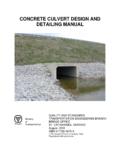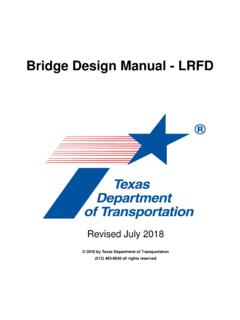Transcription of CHAPTER 7. CULVERT AND BRIDGE HYDRAULIC DESIGN
1 DRAINAGE CRITERIA MANUAL CULVERT AND BRIDGE HYDRAULIC DESIGN City of Bella Vista, AR CB-i CHAPTER 7. CULVERT AND BRIDGE HYDRAULIC DESIGN CONTENTS Section Page CB- culverts introduction AND OVERVIEW .. 1 Required DESIGN Information .. 1 Discharge .. 2 Headwater .. 2 Tailwater .. 3 Outlet Velocity .. 3 CULVERT HYDRAULICS .. 3 Key HYDRAULIC Principles .. 3 Energy and HYDRAULIC Grade Lines .. 4 CULVERT Flow Conditions .. 7 Inlet Control .. 7 Outlet Control .. 8 Energy Losses .. 9 Inlet Losses .. 10 Outlet Losses .. 10 Friction Losses .. 11 CULVERT SIZING AND DESIGN .
2 11 Determination of DESIGN Flow Rate .. 12 DESIGN Frequency and Freeboard Criteria .. 12 Computer Applications .. 13 DESIGN Considerations .. 13 Invert 13 CULVERT Shape, Size and Material .. 13 CULVERT Discharge Velocity .. 14 Minimum Slope .. 15 CULVERT INLETS .. 15 Projecting Inlets .. 16 Corrugated Metal Pipe .. 17 Concrete Pipe .. 17 Inlets with Headwalls .. 18 Corrugated Metal Pipe .. 18 Concrete Pipe .. 19 Wingwalls .. 19 Aprons .. 19 Special Inlets .. 20 Corrugated Metal Pipe .. 21 Concrete Pipe .. 21 Mitered Inlets .. 21 Long Conduit Inlets.
3 21 Improved 22 INLET PROTECTION .. 22 Debris Control .. 22 Buoyancy .. 23 OUTLET PROTECTION .. 24 Scour .. 24 DRAINAGE CRITERIA MANUAL CULVERT AND BRIDGE HYDRAULIC DESIGN CB-ii City of Bella Vista, AR Energy Dissipation/Erosion Control .. 24 Riprap as Outlet Protection .. 25 Length of Protection .. 25 Width of Protection .. 25 Thickness and Stone Size/Gradation .. 26 Multiple Culverts Outlets .. 28 Drop Structures .. 29 Flow Transition Mats .. 29 GENERAL CONSIDERATIONS .. 30 CULVERT Location .. 30 Sedimentation .. 31 Open Channel Inlets .. 31 Transitions.
4 32 CULVERT Replacements .. 33 Fencing for Public Safety .. 33 Cover, Fill Heights and Bedding for Culverts .. 33 BRIDGES introduction AND OVERVIEW .. 34 Coordination with Other Agencies .. 35 Basic Criteria .. 35 DESIGN 35 BRIDGE Opening Freeboard .. 36 HYDRAULIC Analysis .. 36 Backwater .. 36 Expression for Backwater .. 36 Backwater Coefficient .. 39 Effect of M and Abutment Shape (Base Curves) .. 39 Effect of Piers (Normal Crossings).. 41 Scour .. 41 DESIGN Procedure .. 42 Inadequate 43 REFERENCES .. 45 DRAINAGE CRITERIA MANUAL CULVERT AND BRIDGE HYDRAULIC DESIGN City of Bella Vista, AR CB-iii TABLES Table CB-1 Contract Coefficient 10 Table CB-2 DESIGN Storm Frequencies and Minimum Freeboard 12 Table CB-3 Maximum Allowable Discharge Velocities 15 Table CB-4 Inlet Coefficients For Outlet Control 16 Table CB-5 Maximum Heights of Fill Over RCP Culverts 34 Table CB-6 Pipe Bedding Installation Types 34 FIGURES Figure CB-1: Definition of Terms for Closed Conduit Flow.
5 6 Figure CB-2: Definition of Terms for Open Channel Flow .. 6 Figure CB-3: Inlet Control - Unsubmerged 7 Figure CB-4: Inlet Control - Submerged 8 Figure CB-5: Outlet Control - Partially Full Conduit .. 9 Figure CB-6: Outlet Control - Full Conduit .. 9 Figure CB-7: Common Projecting CULVERT Inlets .. 17 Figure CB-8: Inlet with Headwall and Wingwalls .. 18 Figure CB-9: Typical Headwall-Wingwall Configurations .. 20 Figure CB-10: Configuration of Conduit Outlet Protection for Undefined Channel Downstream .. 27 Figure CB-11: CULVERT and Pipe Outlet Erosion Protection .. 28 Figure CB-12: Guidance for Outlet Protection for Multiple Culverts.
6 29 Figure CB-14: Subcritical Flow Transition .. 32 Figure CB-15: Normal BRIDGE Crossing Designation .. 38 Figure CB-16: Base Curves for Wingwall Abutments .. 40 Figure CB-17: Base Curves for Spill-through Abutments .. 40 Figure CB-18: Incremental Backwater Coefficient for Pier .. 44 DRAINAGE CRITERIA MANUAL CULVERT AND BRIDGE HYDRAULIC DESIGN CB-iv City of Bella Vista, AR THIS PAGE INTENTIONALLY LEFT BLANKDRAINAGE CRITERIA MANUAL BRIDGE AND CULVERT HYDRAULIC DESIGN City of Bella Vista, AR CB-1 culverts introduction AND OVERVIEW The purpose of this CHAPTER is to provide guidance for CULVERT and BRIDGE HYDRAULIC DESIGN .
7 The primary objective of a CULVERT or BRIDGE is to convey stormwater flows, based on a DESIGN flow rate, through embankments or under roadways without causing damage to adjacent properties and developments, the roadway, or to the drainage structure. Specifically, this CHAPTER provides information on the criteria and methodology necessary to DESIGN culverts and bridges according to City requirements. The function of a CULVERT is to convey surface water under a roadway, railroad, walking path, or other embankment. In addition to the HYDRAULIC function, the CULVERT must carry construction, highway, railroad, or other traffic and earth loads.
8 Therefore, CULVERT DESIGN involves both HYDRAULIC and structural DESIGN considerations. The HYDRAULIC aspects of CULVERT DESIGN are set forth in this CHAPTER . Culverts are available in a variety of sizes, shapes, and materials. These factors, along with several others, affect their capacity and overall performance. Sizes and shapes may vary from small circular corrugated plastic pipes for driveways to large multiple side-by-side concrete box sections that can be used in lieu of a BRIDGE . A careful approach to CULVERT DESIGN is essential, both in new land development and retrofit situations, because culverts often significantly influence upstream and downstream flood risks, floodplain management and public safety.
9 Culverts can be designed to provide beneficial upstream and downstream conditions and to simultaneously avoid creating a negative visual impact. The information and references necessary to DESIGN culverts according to the procedure given in this CHAPTER can be found in FHWA s HYDRAULIC DESIGN Series, No. 5 (HDS-5 2005 - ), HYDRAULIC DESIGN of Highway Culverts. Required DESIGN Information The HYDRAULIC DESIGN of a CULVERT consists of an analysis of the required performance of the CULVERT to convey flow from one side of an embankment to the other. The designer must select a DESIGN flood frequency, estimate the DESIGN discharge for that frequency, and set an allowable headwater elevation based on the selected DESIGN flood and headwater considerations.
10 These DESIGN criteria are dictated by the City of Bella Vista. The CULVERT size and type can be selected after the DESIGN discharge, controlling DESIGN headwater, slope, tailwater, and allowable outlet velocity have been determined. The DESIGN of a CULVERT requires that the following be determined: Impacts of various CULVERT sizes and dimensions on upstream and downstream flood risks, including the implications of embankment overtopping. How will the proposed CULVERT /embankment fit into the relevant major drainageway master plan? CB-2 City of Bella Vista, AR Are there multipurpose objectives that should be satisfied?


